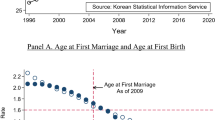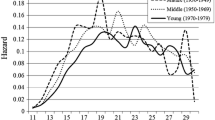Abstract
We investigated the timing of fertility and marriage in Sweden using exogenous variation in the age at school graduation that results from differences in birth month. Our analysis found that the difference of 11 months in the age at leaving school between women who were born in two consecutive months, December and January, implies a delay in the age at first birth of 4.9 months. This effect of delayed graduation also persists for the timing of second births and first marriages, but it does not affect completed fertility or the overall probability of marriage before age 45. These results suggest the existence of a relatively rigid sequencing of demographic events in early adulthood, and the age at graduation from school emerges as an important factor in determining the timing—but not the quantum—of family formation. In addition, these effects point to a potentially important influence of social age, defined by an individual’s school cohort, instead of biological age. The relevance of social age is likely due to social interactions and peer-group influences exerted by individuals who are in the same school cohort but are not necessarily of the same age.
Similar content being viewed by others
References
Alton, A. and A. Massey. 1998. “Date of Birth and Achievement in GCSE and GCE A-Level.” Educational Research 40:105–109.
Andersson, G. 1999. “Childbearing Trends in Sweden, 1961–1997.” European Journal of Population 15(1):1–24.
—. 2002. “Fertility Developments in Norway and Sweden Since the Early 1960s.” Demographic Research 6(4):65–86.
Angrist, J. and A.B. Krueger. 1991. “Does Compulsory School Attendance Affect Schooling and Earnings?” Quarterly Journal of Economics 106:979–1014.
Blossfeld, H.-P. and A. De Rose. 1992. “Educational Expansion and the Changes in Entry Into Marriage and Motherhood: The Experience of Italian Women.” Genus 48(3–4):73–89.
Blossfeld, H.-P. and J. Huinink. 1991. “Human Capital Investments or Norms of Role Transition? How Women’s Schooling and Career Affect the Process of Family Formation.” American Journal of Sociology 97:143–68.
Bound, J. and D.A. Jaeger. 1996. “On the Validity of Season of Birth as an Instrument in Wage Equations: A Comment on Angrist and Krueger’s ‘Does Compulsory School Attendance Affect Schooling and Earnings?’” Working paper 5835. National Bureau of Economic Research, Cambridge, MA.
Corijn, M. 1996. Transition into Adulthood in Flanders. Results From the FFS. The Hague, the Netherlands: NIDI/CBGS Publications.
Costas, M. and M. Palme. 2001. “The Effect of a Social Experiment in Education.” Working Paper 01/11. Institute for Fiscal Studies, London.
Doblhammer, G. and J.W. Vaupel. 2001. “Life Span Depends on Month of Birth.” Proceedings of the National Academy of Sciences 98(5):2934–39.
Goldin, C. and L.F. Katz. 2002. “The Power of the Pill: Oral Contraceptives and Women’s Career and Marriage.” Journal of Political Economy 110:730–70.
Gustafsson, S. 2001. “Optimal Age at Motherhood. Theoretical and Empirical Considerations on Postponement of Maternity in Europe.” Journal of Population Economics 14:225–47.
Hoem, B. 2000. “Entry Into Motherhood in Sweden: The Influence of Economic Factors on the Rise and Fall in Fertility, 1986–1997.” Demographic Research 2(4).
Kohler, H.-P., F.B. Billari, and J.A. Ortega 2002. “The Emergence of Lowest-Low Fertility in Europe During the 1990s.” Population and Development Review 28:641–80.
Marini, M.M. 1984. “The Order of Events in the Transition to Adulthood.” Sociology of Education 57:63–84.
National Social Insurance Board. 2002. Föräldrapenning [Parental benefits]. Stockholm: National Social Insurance Board.
Nonaka, K., I. Nakamura, M. Shimura, and T. Miura. 1987. “Secondary Sex Ratio and the Month of a Mother’s Birth—A Hypothesis of Sex-Ratio-Decreasing Factors.” Progress in Biometeorology 5:51–60.
Plug, E.J.S. 2001. “Season of Birth, Schooling and Earnings.” Journal of Genetic Psychology 22:641–60.
Rosenzweig, M.R. and K.I. Wolpin. 2000. “Natural ‘Natural Experiments’ in Economics.” Journal of Economic Literature 38:827–74.
Sham, P.C., E. O’Callaghan, N. Takei, G.K. Murray, E.H. Hare, and T.M. Murray. 1992. “Schizophrenia Following Prenatal Exposure to Influenza Epidemics Between 1930 and 1960.” British Journal of Psychiatry 160:461–66.
Sharp, C. 1995. “What’s Age Got to Do With It? A Study of Patterns of School Entry and the Impact of Season of Birth on School Attainment.” Educational Research 37:251–65.
Skirbekk, V., H.-P. Kohler, and A. Prskawetz. 2003. “Completing Education and the Timing of Births and Marriage: Findings From a Birth-Month Experiment in Sweden.” Working Paper WP-2003-017. Max Planck Institute for Demographic Research, Rostock, Germany.
Smith, H.L. 1990. “Specification Problems in Experimental and Nonexperimental Social Research.” Sociological Methodology 20:59–91.
Smithers, A.G. and H.J. Cooper. 1984. “Social Class and Season of Birth.” Journal of Social Psychology 124:79–84.
Stanfors, M. 2003. Education, Labor Force Participation and Changing Fertility Patterns. A Study of Women and Socioeconomic Change in Twentieth Century Sweden, Lund Studies in Economic History 22. Stockholm: Almqvist & Wiksell.
Statistics Sweden. 2000. Befolkningsstatistik del 4 för 1999 [Population statistics Part 4 for 1999]. Stockholm: Statistics Sweden.
Statistiska Meddelanden. 1964. Elevernas Ålder Höstterminen 1963 [Age distribution of pupils]. Stockholm: Statistics Sweden.
—. 1968. Elevernas Ålder Höstterminen 1966 [Age distribution of pupils]. Stockholm: Statistics Sweden.
—. 1970. Elevernas Ålder Höstterminen 1969 [Age distribution of pupils]. Stockholm: Statistics Sweden.
Statistisk Tidsskrift. 1962. Elevernas Ålder Höstterminen 1960 [Age distribution of pupils in different sections of the educational system]. Stockholm: Statistics Sweden.
Thompson, A.H., R. Barnsley, and G. Stebelsky. 1991. “Born to Play Ball: The Relative Age Effect and Major League Basketball.” Sociology of Sport Journal 8:146–51.
Westoff, C.F. and N.B. Ryder. 1977. The Contraceptive Revolution. Princeton, NJ: Princeton University Press.
Author information
Authors and Affiliations
Additional information
The authors thank Gunnar Andersson, Jan Hoem, Birgitta Lidholt, Ingrid Lindskog, Jonathan MacGill, and Michaela Kreyenfeld for their valuable help in writing this article, and express their gratitude to the Max Planck Institute for Demographic Research for supporting this project. A large part of this work was undertaken while Skirbekk and Prskawetz were working at the Max Planck Institute. Skirbekk acknowledges the financial support (contract HPRN-CT-2001-00234) of the European Community’s Human Potential Programme.
Rights and permissions
About this article
Cite this article
Skirbekk, V., Kohler, HP. & Prskawetz, A. Birth month, school graduation, and the timing of births and marriages. Demography 41, 547–568 (2004). https://doi.org/10.1353/dem.2004.0028
Issue Date:
DOI: https://doi.org/10.1353/dem.2004.0028




